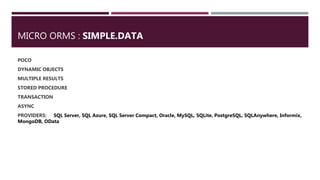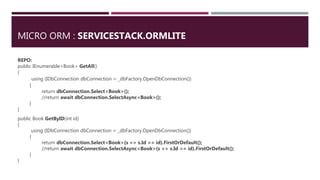Ad
Entity Framework Core & Micro-Orms with Asp.Net Core
- 1. ASPNET CORE DATA ACCESS ENTITY FRAMEWORK CORE & MICRO ORMS
- 2. ETAT DES LIEUX : EF CORE 1.0 Nouvelles plateformes .NET CORE (ASP.NET Core, UWP) .NET Framework (ASP.NET, WPF, Windows Forms) XAMARIN Windows Phone Windows Store MAC Linux
- 3. ETAT DES LIEUX : EF CORE 1.0 Nouvelles sources de données Relationnelles (SQL Server, SQL Lite, SQL Compact, Postgres, MySQL, Oracle) Non relationnelles (Redis, Azure Table Storage) InMemory (à utiliser pour les test) Providers disponibles uniquement pour les SGBD relationnels pour la v 1.0 Possibilité de créer son propre provider
- 4. ENTITY FRAMEWORK CORE 1.0 On repart de Zero mais on garde le meilleur Code First Code First from Database Approche totalement modulaire IOC friendly Totalement Open source comme tout ce qui finit par Core… donc code source disponible sur GitHub et possiblité de contribuer son l’évolution. EF Core n’est pas production ready
- 5. ENTITY FRAMEWORK CORE 1.0 Fonctionnalités legacy Change tracking Migrations DbContext API Linq to Entities SaveChanges Fonctionnalités supprimées EDMX Entity SQL Complex Mapping Migrations automatiques
- 6. ENTITY FRAMEWORK CORE 1.0 Nouvelles fonctionnalités Dependency injection Lancer des Batch avec CUD Créer des clé étrangères SQL généré plus propre et plus light Amélioration des graphes d’objets déconnectés Fonctionnalités à venir Mapping des procédures stockées Lazy loading
- 7. ENTITY FRAMEWORK CORE 1.0.1 DEMARRAGE
- 8. ENTITY FRAMEWORK CORE 1.0 Package à installer "Microsoft.EntityFrameworkCore.SqlServer": "1.0.1 " Création d’un DbContext public class CookBookContext : DbContext { public CookBookContext(DbContextOptions<CookBookContext> options) : base(options) { } public DbSet<Book> Book { get; set; } public DbSet<Recipe> Recipe { get; set; } }
- 9. ENTITY FRAMEWORK CORE 1.0 Config dans appsettings.json { "ConnectionStrings": { "DbConnection": "Data Source=mcnltp173;Initial Catalog=CookBook;Integrated Security=True" } } Config dans Startup.cs public void ConfigureServices(IServiceCollection services) { services.AddDbContext<CookBookContext>( options => options.UseSqlServer(Configuration.GetConnectionString("DbConnection"))); }
- 10. ENTITY FRAMEWORK CORE 1.0 Utilisation public class HomeController : Controller { private readonly CookBookContext _context; public HomeController(CookBookContext context) { _context = context; } public IActionResult Index() { var books = _context.Book.ToList(); return View(books); } }
- 11. ENTITY FRAMEWORK CORE 1.0.1 REVERSE ENGINEERING
- 12. ENTITY FRAMEWORK CORE 1.0 Command dotnet ef dbcontext scaffold -c DbContextName -o ModelsFolder "MyConnectionString" Microsoft.EntityFrameworkCore.SqlServer –force Config dans project.json "dependencies": { "Microsoft.EntityFrameworkCore.SqlServer": "1.0.1", "Microsoft.EntityFrameworkCore.SqlServer.Design": "1.0.1", "Microsoft.EntityFrameworkCore.Design": "1.0.0-preview2-final" }, "tools": { "Microsoft.EntityFrameworkCore.Tools": "1.0.0-preview2-final" }
- 13. ENTITY FRAMEWORK CORE 1.0 Code généré public partial class CookBookContext : DbContext { protected override void OnConfiguring(DbContextOptionsBuilder optionsBuilder) { optionsBuilder.UseSqlServer( @"Data Source=mcnltp173;Initial Catalog=CookBook;Integrated Security=True"); } protected override void OnModelCreating(ModelBuilder modelBuilder) { modelBuilder.Entity<Book>(entity => { entity.Property(e => e.Name) .IsRequired() .HasColumnType("varchar(50)"); }); } public virtual DbSet<Book> Book { get; set; } public virtual DbSet<Recipe> Recipe { get; set; } }
- 14. MICRO ORMS DAPPER - PETAPOCO - MASSIVE - SIMPLE.DATA - SERVICESTACK.ORMLITE
- 15. MICRO ORMS : DAPPER POCO DYNAMIC OBJECTS MULTIPLE RESULTS STORED PROCEDURE TRANSACTION ASYNC PROVIDERS: SQLLite, SQL CE, Firebird, Oracle, MySQL, PostgreSQL and SQL Server
- 16. MICRO ORMS : DAPPER CONFIG: public void ConfigureServices(IServiceCollection services) { services.Add(new ServiceDescriptor(typeof(IConfiguration), provider => new ConfigurationBuilder() .SetBasePath(Directory.GetCurrentDirectory()) .AddJsonFile("appsettings.json", optional: false, reloadOnChange: true) .Build(), ServiceLifetime.Singleton)); services.AddScoped<ICookBookRepository, CookBookRepository>(); } // ou (v2) : public static IConfigurationRoot Configuration; public void ConfigureServices(IServiceCollection services) { services.AddScoped<ICookBookRepository, CookBookRepository>(); }
- 17. MICRO ORMS : DAPPER CTOR: private readonly IConfiguration _config; public CookBookRepository(IConfiguration config) { _config = config; } public IDbConnection Connection { get { return new SqlConnection(_config.GetConnectionString("DbConnection");); } } // ou (v2) : public IDbConnection Connection { get { return new SqlConnection(Startup.Configuration["connectionStrings:DbConnection"]);
- 18. MICRO ORMS : DAPPER REPO: public IEnumerable<Book> GetAll() { using (IDbConnection db = Connection) { db.Open(); // version requete Sql return db.Query<Book>("SELECT * FROM Book").ToList<Book>; //return await db.QueryAsync<Book>("SELECT * FROM Book"); // version ps //return db.Query<Book>("GetAllBooks", commandType: CommandType.StoredProcedure); } }
- 19. MICRO ORMS : DAPPER public Book GetByID(int id) { using (IDbConnection db = Connection) { db.Open(); // version requete Sql string sQuery = "SELECT * FROM Book WHERE Id = @Id"; return db.Query<Book>(sQuery, new { Id = id }).FirstOrDefault(); // version ps //string sp = "GetBookByID"; //var parameter = new DynamicParameters(); //parameter.Add("@Id", id, dbType: DbType.Int32, direction: ParameterDirection.Input); //return db.Query<Book>(sp, parameter, commandType: CommandType.StoredProcedure).FirstOrDefault(); } }
- 20. MICRO ORMS : DAPPER public Book GetMultiple(int id) { using (IDbConnection db = Connection) { db.Open(); // version requete Sql //string query = "SELECT * FROM Book WHERE Id=@id; SELECT * FROM Recipe WHERE IdBook=@id;"; //var multipleResults = db.QueryMultiple(query, new { id = id }); // version sp var parameter = new DynamicParameters(); parameter.Add("@id", id, dbType: DbType.Int32, direction: ParameterDirection.Input); var multipleResults = db.QueryMultiple("GetBookRecipes", parameter, commandType: CommandType.StoredProcedure); var book = multipleResults.Read<Book>().SingleOrDefault(); var recipes = multipleResults.Read<Recipe>().ToList(); if (book != null && recipes != null) book.Recipes = new List<Recipe>(); book.Recipes.AddRange(recipes); return book; }
- 21. MICRO ORMS : DAPPER public void Add(Book book) { using (IDbConnection db = Connection) { db.Open(); var parameter = new DynamicParameters(); parameter.Add("@name", book.Name, dbType: DbType.String, direction: ParameterDirection.Input); //string sQuery = "INSERT INTO Book (Name) VALUES(@Name)"; // version 1 requete Sql //db.Execute(sQuery, parameter); // version 2 requete Sql //db.Execute(sQuery, book); // version sp db.Execute("InsertBook", parameter, commandType: CommandType.StoredProcedure); } }
- 22. MICRO ORMS : DAPPER public void Update(Book book) { using (IDbConnection db = Connection) { db.Open(); var parameters = new DynamicParameters(); parameters.Add("@Id", book.Id, dbType: DbType.Int32, direction: ParameterDirection.Input); parameters.Add("@Name", book.Name, dbType: DbType.String, direction: ParameterDirection.Input); string sQuery = "UPDATE Book SET Name = @Name WHERE Id = @Id"; // version 1 requete Sql //db.Execute(sQuery, parameters, commandType: CommandType.Text); // version 2 requete Sql //db.Execute(sQuery, book, commandType: CommandType.Text); // version sp db.Execute("UpdateBook", parameters, commandType: CommandType.StoredProcedure); } }
- 23. MICRO ORMS : DAPPER public void Delete(int id) { using (IDbConnection db = Connection) { db.Open(); // version 1 requete Sql //string sQuery = "DELETE FROM Book WHERE Id = @Id"; //db.Execute(sQuery, new { Id = id }); // version sp var parameter = new DynamicParameters(); parameter.Add("@Id", id, dbType: DbType.Int32, direction: ParameterDirection.Input); string sp = "DeleteBook"; db.Execute(sp, parameter, commandType: CommandType.StoredProcedure); } }
- 24. MICRO ORMS : PETAPOCO POCO DYNAMIC OBJECTS MAPPING MULTIPLE RESULTS STORED PROCEDURE TRANSACTION ASYNC T4 PROVIDERS: SQL Server, SQL Server CE, MS Access, SQLite, MySQL, MariaDB, PostgreSQL, Firebird DB, and Oracle APP.CONFIG
- 25. MICRO ORMS : PETAPOCO CONFIG: public void ConfigureServices(IServiceCollection services) { services.AddScoped<ICookBookRepository, CookBookRepository>(); } CTOR: private readonly Database _db; public CookBookRepository() { var connectionString = ConfigurationManager.ConnectionStrings["DbConnection"].ConnectionString; _db = new Database(connectionString, new SqlServerDatabaseProvider()); }
- 26. MICRO ORMS : PETAPOCO REPO: public IEnumerable<Book> GetAll() { using (IDatabase dbConnection = Connection) { return _db.Query<Book>("SELECT * FROM Book"); } } public Book GetByID(int id) { using (IDatabase dbConnection = Connection) { return _db.FirstOrDefault<Book>($"SELECT * FROM Book WHERE Id={id}"); } }
- 27. MICRO ORMS : PETAPOCO public void Add(Book book) { using (IDatabase dbConnection = Connection) { _db.Insert(book); } } public void Update(Book book) { using (IDatabase dbConnection = Connection) { _db.Update(book); } } public void Delete(Book book) { using (IDatabase dbConnection = Connection) { _db.Delete(book); } }
- 28. MICRO ORMS : MASSIVE DYNAMIC OBJECTS MULTIPLE RESULTS STORED PROCEDURE TRANSACTION ASYNC PROVIDERS: SQL Server, Oracle, SQLite, PostgreSQL APP.CONFIG
- 29. MICRO ORMS : MASSIVE CONFIG: public void ConfigureServices(IServiceCollection services) { services.AddScoped<ICookBookRepository, CookBookRepository>(); } public class Book : DynamicModel { public Book():base("DbConnection", "Book","Id") { } public int Id { get; set; } public string Name { get; set; } }
- 30. MICRO ORMS : MASSIVE REPO: public async Task<IList<dynamic>> GetAll() { return await table.AllAsync(); } public async Task<dynamic> GetByID(int id) { return await table.SingleAsync($"WHERE Id={id}"); }
- 31. MICRO ORMS : MASSIVE public async Task Add(dynamic book) { await table.InsertAsync(book); } public async Task Update(dynamic book) { await table.UpdateAsync(book, book.Id); } public async Task Delete(int id) { await table.DeleteAsync(id); }
- 32. MICRO ORMS : SIMPLE.DATA POCO DYNAMIC OBJECTS MULTIPLE RESULTS STORED PROCEDURE TRANSACTION ASYNC PROVIDERS: SQL Server, SQL Azure, SQL Server Compact, Oracle, MySQL, SQLite, PostgreSQL, SQLAnywhere, Informix, MongoDB, OData
- 33. MICRO ORMS : SIMPLE.DATA CONFIG: public Startup(IHostingEnvironment env) { var builder = new ConfigurationBuilder() .SetBasePath(env.ContentRootPath) .AddJsonFile("appsettings.json", optional: true, reloadOnChange: true); Configuration = builder.Build(); } public static IConfigurationRoot Configuration; public void ConfigureServices(IServiceCollection services) { services.AddScoped<ICookBookRepository, CookBookRepository>() } CTOR: private readonly dynamic _db; public CookBookRepository() { _db = Database.OpenConnection(Startup.Configuration["connectionStrings:DbConnection"]); }
- 34. MICRO ORMS : SIMPLE.DATA REPO: public async Task<List<Book>> GetAll() { return await _db.Book.All().ToList<Book>(); //return await _db["Book"].All().ToList<Book>(); } public async Task<Book> GetByID(int id) { return await _db.Book.Find(_db.Book.Id == id); //return await _db.Book.Get(id).Cast<Book>(); }
- 35. MICRO ORMS : SIMPLE.DATA public async Task Add(Book book) { await _db.Book.Insert(book); } public async Task Update(Book book) { await _db.Book.UpdateById(Id: book.Id, Name: book.Name); } public async Task Delete(int id) { await _db.Book.DeleteById(id); }
- 36. MICRO ORMS : SERVICESTACK.ORMLITE POCO DYNAMIC OBJECTS MULTIPLE RESULTS STORED PROCEDURE TRANSACTION ASYNC PROVIDERS: SqlServer, PostgreSQL, MySql, Sqlite.Mono, Sqlite.Windows, Oracle, Firebird, VistaDb, AWS RDS (PostgreSQL, Aurora, MySQL, MariaDB, SQL Server)
- 37. MICRO ORMS : SERVICESTACK.ORMLITE CONFIG: public void ConfigureServices(IServiceCollection services) { services.AddScoped<ICookBookRepository, CookBookRepository>(); } CTOR: private readonly IDbConnectionFactory _dbFactory; public CookBookRepository() { _dbFactory = new OrmLiteConnectionFactory( Startup.Configuration["connectionStrings:DbConnection"], SqlServer2012Dialect.Provider); }
- 38. MICRO ORM : SERVICESTACK.ORMLITE REPO: public IEnumerable<Book> GetAll() { using (IDbConnection dbConnection = _dbFactory.OpenDbConnection()) { return dbConnection.Select<Book>(); //return await dbConnection.SelectAsync<Book>(); } } public Book GetByID(int id) { using (IDbConnection dbConnection = _dbFactory.OpenDbConnection()) { return dbConnection.Select<Book>(s => s.Id == id).FirstOrDefault(); //return await dbConnection.SelectAsync<Book>(s => s.Id == id).FirstOrDefault(); } }
- 39. MICRO ORMS : SERVICESTACK.ORMLITE public void Add(Book book) { using (IDbConnection dbConnection = _dbFactory.OpenDbConnection()) { dbConnection.Insert<Book>(book); // await dbConnection.InsertAsync<Book>(book); } } public void Delete(int id) { using (IDbConnection dbConnection = _dbFactory.OpenDbConnection()) { dbConnection.Delete<Book>(s => s.Id == id); // await dbConnection.DeleteAsync<Book>(s => s.Id == id); } }
- 40. MICRO ORMS : SERVICESTACK.ORMLITE public void Update(Book book) { using (IDbConnection dbConnection = _dbFactory.OpenDbConnection()) { // dbConnection.Update<Book>( // dbConnection.UpdateAdd<Book>( // dbConnection.UpdateAll<Book>( // await dbConnection.UpdateOnlyAsync<Book>( dbConnection.UpdateOnly<Book>( book, onlyFields: f => f.Name == book.Name, where: s => s.Id == book.Id ); } }
- 41. LINKS PETAPOCO http://www.toptensoftware.com/petapoco/ https://github.com/CollaboratingPlatypus/PetaPoco MASSIVE OK https://github.com/FransBouma/Massive ORMLITE OK https://github.com/ServiceStack/ServiceStack.OrmLite http://gistlyn.com/?collection=991db51e44674ad01d3d318b24cf0934&gist=a62b1e7a8da57c7d1fda95b3da5303eb SIMPLEDATA OK https://github.com/markrendle/Simple.Data DAPPER OK https://github.com/StackExchange/dapper-dot-net

















![MICRO ORMS : DAPPER
CTOR:
private readonly IConfiguration _config;
public CookBookRepository(IConfiguration config)
{
_config = config;
}
public IDbConnection Connection
{
get
{
return new SqlConnection(_config.GetConnectionString("DbConnection"););
}
}
// ou (v2) :
public IDbConnection Connection
{
get
{
return new SqlConnection(Startup.Configuration["connectionStrings:DbConnection"]);](https://image.slidesharecdn.com/entityframeworkcore-microorms-170127130406/85/Entity-Framework-Core-Micro-Orms-with-Asp-Net-Core-17-320.jpg)







![MICRO ORMS : PETAPOCO
CONFIG:
public void ConfigureServices(IServiceCollection services)
{
services.AddScoped<ICookBookRepository, CookBookRepository>();
}
CTOR:
private readonly Database _db;
public CookBookRepository()
{
var connectionString = ConfigurationManager.ConnectionStrings["DbConnection"].ConnectionString;
_db = new Database(connectionString, new SqlServerDatabaseProvider());
}](https://image.slidesharecdn.com/entityframeworkcore-microorms-170127130406/85/Entity-Framework-Core-Micro-Orms-with-Asp-Net-Core-25-320.jpg)







![MICRO ORMS : SIMPLE.DATA
CONFIG:
public Startup(IHostingEnvironment env)
{
var builder = new ConfigurationBuilder()
.SetBasePath(env.ContentRootPath)
.AddJsonFile("appsettings.json", optional: true, reloadOnChange: true);
Configuration = builder.Build();
}
public static IConfigurationRoot Configuration;
public void ConfigureServices(IServiceCollection services)
{
services.AddScoped<ICookBookRepository, CookBookRepository>()
}
CTOR:
private readonly dynamic _db;
public CookBookRepository()
{
_db = Database.OpenConnection(Startup.Configuration["connectionStrings:DbConnection"]);
}](https://image.slidesharecdn.com/entityframeworkcore-microorms-170127130406/85/Entity-Framework-Core-Micro-Orms-with-Asp-Net-Core-33-320.jpg)
![MICRO ORMS : SIMPLE.DATA
REPO:
public async Task<List<Book>> GetAll()
{
return await _db.Book.All().ToList<Book>();
//return await _db["Book"].All().ToList<Book>();
}
public async Task<Book> GetByID(int id)
{
return await _db.Book.Find(_db.Book.Id == id);
//return await _db.Book.Get(id).Cast<Book>();
}](https://image.slidesharecdn.com/entityframeworkcore-microorms-170127130406/85/Entity-Framework-Core-Micro-Orms-with-Asp-Net-Core-34-320.jpg)


![MICRO ORMS : SERVICESTACK.ORMLITE
CONFIG:
public void ConfigureServices(IServiceCollection services)
{
services.AddScoped<ICookBookRepository, CookBookRepository>();
}
CTOR:
private readonly IDbConnectionFactory _dbFactory;
public CookBookRepository()
{
_dbFactory = new OrmLiteConnectionFactory(
Startup.Configuration["connectionStrings:DbConnection"],
SqlServer2012Dialect.Provider);
}](https://image.slidesharecdn.com/entityframeworkcore-microorms-170127130406/85/Entity-Framework-Core-Micro-Orms-with-Asp-Net-Core-37-320.jpg)


























































































